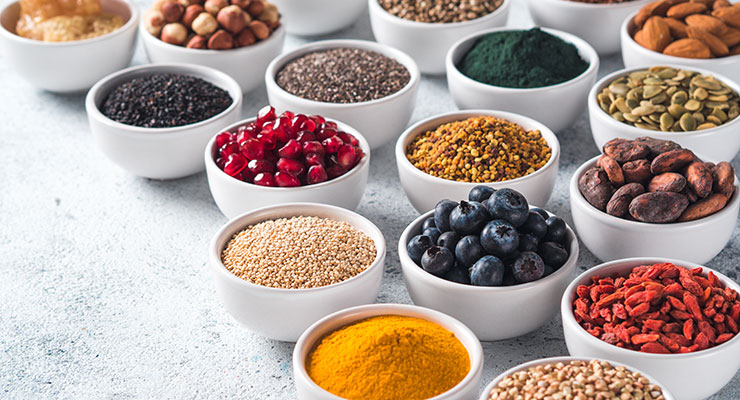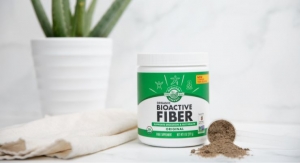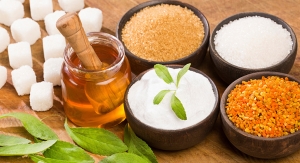By Navin M. Geria, Ayurderm Technologies, LLC09.01.22
Skin care marketers and chemists are obsessed with “superfoods,” and for good reason. Adding antioxidant-rich superfood ingredients to skin care is the new trend, inspired by studies, papers, and reports from academics, suppliers, business analysts, and other experts.
Dermatologist Dennis Gross said superfoods, including avocados, cacao, kiwi, kakadu, and coffee, can help heal, repair, and prevent skin conditions. With an increasing focus on self-care and wellness, skin care and personal grooming products are popular. The wellness trend may be fueling a rise in clean beauty and superfood-based products, too.
Yet, there is no scientifically-based or regulated definition for “superfood.” According to Stephanie Mattucci, global food science analyst at Mintel, superfoods are seen as healthy, nutrient-dense, or antioxidant-rich foods. The term superfoods continues to tap into that desire to be healthy and is often used to promote the benefits of nutritionally-dense foods. Superfoods, a term coined by marketers, usually have a high content of vitamins, nutrients, and antioxidants.
According to Dermatologist Neil Sadick, the term superfood just refers to common food items that have high levels of valuable ingredients such as omega oils and antioxidants. On the other hand, Dermatologist Amy Ross said that new products include superfood ingredients such as mushrooms and moringa oil in addition to more familiar names such as green tea, seaweed, jojoba oil, papaya, and blueberries. Health benefits of superfoods are well known and their success among consumers is now extending to skin care.
A “Superfoods for Your Skin” article, published in Bloomberg (Jan. 31, 2022), noted that the star ingredients from your grocery store are becoming key components in facial products. Salmon brightens and evens skin tone, okra hydrates the eye area, artichoke protects against skin damage, bell pepper combats photoaging, and rice fights aging. Even grains have become an important part of the cosmetic industry due to their numerous beneficial qualities for skin and hair. Other antioxidant-rich ingredients finding their way into beauty products include kale, avocado, broccoli, pomegranate, green tea, goji berries, chia seeds,
and quinoa.
Superfoods provide our body with the building blocks it needs to function optimally, and now their benefits are being delivered directly to the skin topically, according to Dermatologist Joshua Zeichner, director of cosmetic and clinical research in dermatology, Mount Sinai Hospital. This article briefly reviews superfoods in skin care.
According to a Whole Foods Market report, the ingredient labels on your skin care products often read like a juice bar menu. Cosmetic companies have discovered that superfoods also benefit the skin. Skin care companies are targeting the health- and beauty-conscious segment of the market. According to Tara Lewis, Yelp Inc.’s trend expert, consumers are discovering parallels that exist between beauty, nutrition, and wellness. The properties of superfoods typically align with many skin care staples from antioxidants to anti-inflammatories.
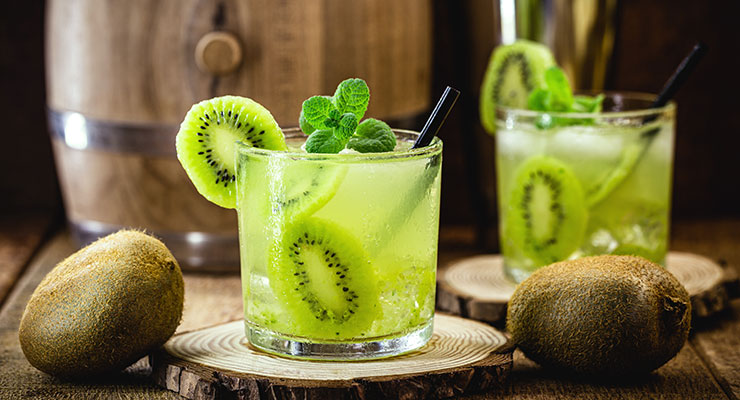
Rossi said formulation is key to help deliver star ingredients. Certain plant botanicals and peptides can be extracted or synthesized from these and made soluble for skin preparations. He is launching a clean, clinical skin-care line called Dr. Rossi Derm MD.
Oculofacial Plastic Surgeon Dr. Robert Schwarcz is also bullish on these nutritional treatments. He insisted high-intensity plant extracts should be formulated into high-end products. In fact, Schwarcz is launching Orvos Skin Science.
According to Dr. Jenny Kim, professor of clinical medicine at the David Geffen School of Medicine at UCLA and chief of dermatology, when used as a topical ingredient, avocado may play a role in collagen synthesis and wound healing.
A 2018 edition of Molecules, a peer-reviewed chemistry journal, published an Italian study that found artichoke extract contained polyphenols that may act as an anti-inflammatory, protecting against oxidative damage. The aging population spends billions of dollars each year on vitamins, minerals, botanical extracts, and antioxidants in an effort to maintain a youthful appearance of the skin and promote overall well-being.
According to Precedence Market Research, the nutricosmetics market was estimated at $6.4 billion in 2021 and is predicted to surpass $15.6 billions by 2030, expanding growth at a 10.4% from 2022 to 2030. Some superfoods also supply essential fatty acids and vital replenishing ingredients to enrich and strengthen skin’s surface. Most well-researched superfoods with respect to skin care can be found in Table 1.
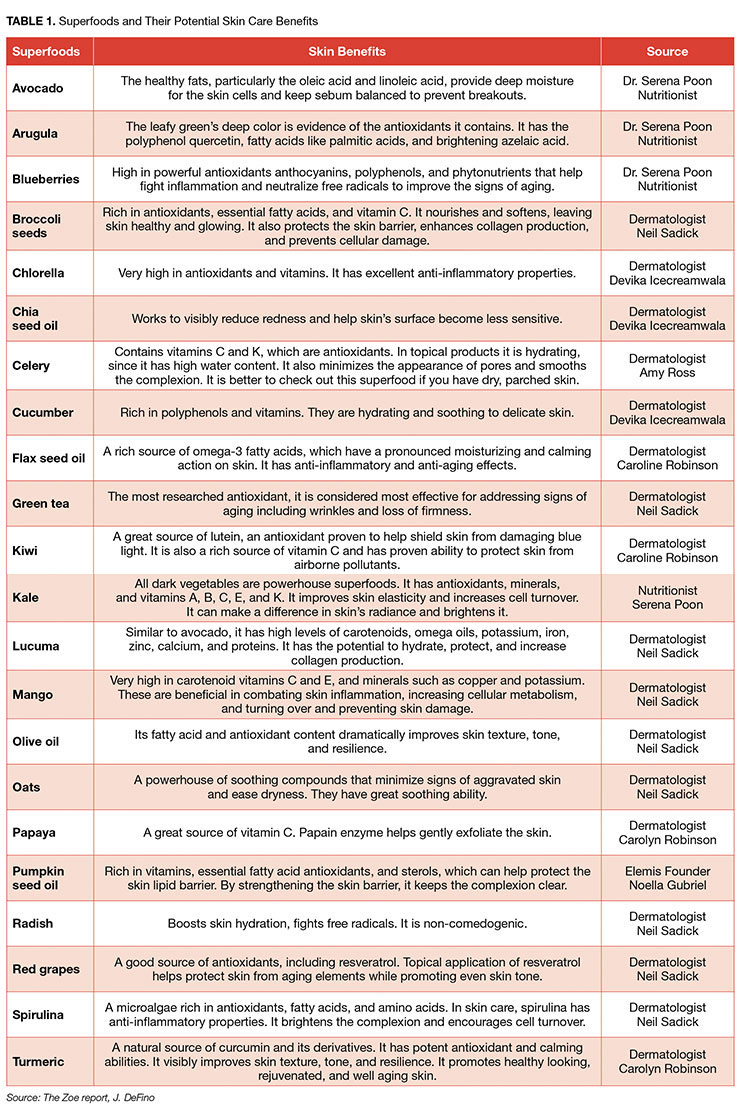
Dennis Gross’s B3 Adaptive Superfoods range includes Rescue Serum Barrier Repair Face Cream and SOS Eye Cream. Brands such as Youth to the People, Kiehl’s, Shiseido, and Aveeno are harnessing ingredients such as kombucha, oat milk, cherry juice, ginger, and green tea. Aveda promotes its Mushroom Skin Relief Soothing Treatment Lotion to consumers looking for the superfood beauty experience. The formula contains reishi mushroom extract, claimed to have immune-boosting properties.
Byroe skin care products are formulated with nutrient-rich ingredients to nourish the skin. According to the company, Golden Carrot Overnight Relief Mask contains carrot to boost cell turnover and soothe stressed skin. Encapsulated ginger brightens dark spots and vegan collagen improves barrier skin. Both Tofu Gel Cream and Salmon Cream aim to brighten, soften, and firm skin using the omega-3 fatty acids and proteins found in salmon caviar extract, egg yolk, and niacinamide.
Elemis offers its superfood skin care collection as the recipe for glowing skin. The products are said to be packed with balancing probiotics, fermented plant actives, and vitamin-rich superfoods. A top formula is Superfood Blackcurrant Jelly Exfoliator.

Golde formulas are made with superfood ingredients. Products include Pear Serum Oil, Bell Pepper Serum, Tomato Serum, and Bitter Green Essence Toner.
Youth to the People’s Superfood Firm and Brighten Serum contains kale, spinach, and green tea extracts combined with hyaluronic acid to hydrate and plump; vitamin C to rejuvenate; and tripeptide-5 to improve fine lines and wrinkles. YTTP’s Adaptogen Deep Moisture Cream contains reishi mushroom extract. According to the National Center for Biotechnology Information, mushroom extracts are capable of accelerating the skin turnover rate.
Turtle Jelly Bomb from Lush contains seaweed absolute for its skin soothing properties.
Pholk Beauty’s Perk Up Eye Nectar uses linoleic and oleic acids derived from okra seed oil to hydrate the eye area.
Nooni’s Black Superfood Face Mask combines soybeans, rice, and sesame extract to help draw out impurities from the skin.
About the Author: Navin Geria, former Pfizer Research Fellow, is a cosmetic and pharmaceutical product development chemist and the chief scientific officer of AyurDerm Technologies LLC, which provides Ayurvedic, natural, and cosmeceutical custom formulation development and consulting services to the spa-wellness-dermatology industries. He has launched dozens of cosmeceutical and Ayurvedic anti-aging products. Geria has more than 30 years of experience in the personal care industry and was previously with Clairol, Warner-Lambert, Schick-Energizer, Bristol-Myers, and Spa Dermaceuticals. He has nearly 20 U.S. patents and has been published extensively. Geria edited the Handbook of Skin Anti-Aging Theories for Cosmetic Formulation Development book published in April 2016 by Harry’s Cosmeticology. He is a speaker, moderator, and chairman at cosmetic industry events. He is Director of R&D for S & A Technologies, Rolla, MO, responsible for developing new dermatological/cosmeceutical products and also participates in developing products resulting from National Institute of Health-funded research. Contact him at: navin@ayurderm.com.
Dermatologist Dennis Gross said superfoods, including avocados, cacao, kiwi, kakadu, and coffee, can help heal, repair, and prevent skin conditions. With an increasing focus on self-care and wellness, skin care and personal grooming products are popular. The wellness trend may be fueling a rise in clean beauty and superfood-based products, too.
Yet, there is no scientifically-based or regulated definition for “superfood.” According to Stephanie Mattucci, global food science analyst at Mintel, superfoods are seen as healthy, nutrient-dense, or antioxidant-rich foods. The term superfoods continues to tap into that desire to be healthy and is often used to promote the benefits of nutritionally-dense foods. Superfoods, a term coined by marketers, usually have a high content of vitamins, nutrients, and antioxidants.
According to Dermatologist Neil Sadick, the term superfood just refers to common food items that have high levels of valuable ingredients such as omega oils and antioxidants. On the other hand, Dermatologist Amy Ross said that new products include superfood ingredients such as mushrooms and moringa oil in addition to more familiar names such as green tea, seaweed, jojoba oil, papaya, and blueberries. Health benefits of superfoods are well known and their success among consumers is now extending to skin care.
A “Superfoods for Your Skin” article, published in Bloomberg (Jan. 31, 2022), noted that the star ingredients from your grocery store are becoming key components in facial products. Salmon brightens and evens skin tone, okra hydrates the eye area, artichoke protects against skin damage, bell pepper combats photoaging, and rice fights aging. Even grains have become an important part of the cosmetic industry due to their numerous beneficial qualities for skin and hair. Other antioxidant-rich ingredients finding their way into beauty products include kale, avocado, broccoli, pomegranate, green tea, goji berries, chia seeds,
and quinoa.
Superfoods provide our body with the building blocks it needs to function optimally, and now their benefits are being delivered directly to the skin topically, according to Dermatologist Joshua Zeichner, director of cosmetic and clinical research in dermatology, Mount Sinai Hospital. This article briefly reviews superfoods in skin care.
According to a Whole Foods Market report, the ingredient labels on your skin care products often read like a juice bar menu. Cosmetic companies have discovered that superfoods also benefit the skin. Skin care companies are targeting the health- and beauty-conscious segment of the market. According to Tara Lewis, Yelp Inc.’s trend expert, consumers are discovering parallels that exist between beauty, nutrition, and wellness. The properties of superfoods typically align with many skin care staples from antioxidants to anti-inflammatories.

A Wealth of Misinformation
Kale, blueberries, and spinach are common ingredients in facial products, and part of the “clean” and natural beauty movement that continues to gather strength. But just like the clean beauty category, the superfood category is overhyped and misunderstood. There is a big difference between eating a superfood and smearing it on your face, noted Dermatologist Anthony Rossi. Mixing superfoods in a blender and adding them into skin care formulas doesn’t work—skin cannot readily extract the key active ingredients from these foods.Rossi said formulation is key to help deliver star ingredients. Certain plant botanicals and peptides can be extracted or synthesized from these and made soluble for skin preparations. He is launching a clean, clinical skin-care line called Dr. Rossi Derm MD.
Oculofacial Plastic Surgeon Dr. Robert Schwarcz is also bullish on these nutritional treatments. He insisted high-intensity plant extracts should be formulated into high-end products. In fact, Schwarcz is launching Orvos Skin Science.
According to Dr. Jenny Kim, professor of clinical medicine at the David Geffen School of Medicine at UCLA and chief of dermatology, when used as a topical ingredient, avocado may play a role in collagen synthesis and wound healing.
A 2018 edition of Molecules, a peer-reviewed chemistry journal, published an Italian study that found artichoke extract contained polyphenols that may act as an anti-inflammatory, protecting against oxidative damage. The aging population spends billions of dollars each year on vitamins, minerals, botanical extracts, and antioxidants in an effort to maintain a youthful appearance of the skin and promote overall well-being.
According to Precedence Market Research, the nutricosmetics market was estimated at $6.4 billion in 2021 and is predicted to surpass $15.6 billions by 2030, expanding growth at a 10.4% from 2022 to 2030. Some superfoods also supply essential fatty acids and vital replenishing ingredients to enrich and strengthen skin’s surface. Most well-researched superfoods with respect to skin care can be found in Table 1.

What’s On the Market?
The number of “superfood” cosmetic products have tripled in the past five years, according to Mintel market research. Leading the way are prestige brands such as Origins, Aveda, and Kiehl’s. In December, L’Oréal signed an agreement to acquire U.S. superfoods skin care specialist, Youth to the People. The brand’s use of superfoods lands well in the current consumer climate, as many are seeking natural products.Dennis Gross’s B3 Adaptive Superfoods range includes Rescue Serum Barrier Repair Face Cream and SOS Eye Cream. Brands such as Youth to the People, Kiehl’s, Shiseido, and Aveeno are harnessing ingredients such as kombucha, oat milk, cherry juice, ginger, and green tea. Aveda promotes its Mushroom Skin Relief Soothing Treatment Lotion to consumers looking for the superfood beauty experience. The formula contains reishi mushroom extract, claimed to have immune-boosting properties.
Byroe skin care products are formulated with nutrient-rich ingredients to nourish the skin. According to the company, Golden Carrot Overnight Relief Mask contains carrot to boost cell turnover and soothe stressed skin. Encapsulated ginger brightens dark spots and vegan collagen improves barrier skin. Both Tofu Gel Cream and Salmon Cream aim to brighten, soften, and firm skin using the omega-3 fatty acids and proteins found in salmon caviar extract, egg yolk, and niacinamide.
Elemis offers its superfood skin care collection as the recipe for glowing skin. The products are said to be packed with balancing probiotics, fermented plant actives, and vitamin-rich superfoods. A top formula is Superfood Blackcurrant Jelly Exfoliator.

Golde formulas are made with superfood ingredients. Products include Pear Serum Oil, Bell Pepper Serum, Tomato Serum, and Bitter Green Essence Toner.
Youth to the People’s Superfood Firm and Brighten Serum contains kale, spinach, and green tea extracts combined with hyaluronic acid to hydrate and plump; vitamin C to rejuvenate; and tripeptide-5 to improve fine lines and wrinkles. YTTP’s Adaptogen Deep Moisture Cream contains reishi mushroom extract. According to the National Center for Biotechnology Information, mushroom extracts are capable of accelerating the skin turnover rate.
Turtle Jelly Bomb from Lush contains seaweed absolute for its skin soothing properties.
Pholk Beauty’s Perk Up Eye Nectar uses linoleic and oleic acids derived from okra seed oil to hydrate the eye area.
Nooni’s Black Superfood Face Mask combines soybeans, rice, and sesame extract to help draw out impurities from the skin.
Conclusion
Many skin problems are usually caused by inflammation, stress, and environmental pollution. Incorporating superfood ingredients to cosmetic products to combat inflammation makes sense. Although grains are rich in fibers and minerals, their benefits for skin remain a mystery to many. Dermatologist Shereene Idriss said there must be skin-caring merit to many of these superfoods, but that merit has yet to be proven.About the Author: Navin Geria, former Pfizer Research Fellow, is a cosmetic and pharmaceutical product development chemist and the chief scientific officer of AyurDerm Technologies LLC, which provides Ayurvedic, natural, and cosmeceutical custom formulation development and consulting services to the spa-wellness-dermatology industries. He has launched dozens of cosmeceutical and Ayurvedic anti-aging products. Geria has more than 30 years of experience in the personal care industry and was previously with Clairol, Warner-Lambert, Schick-Energizer, Bristol-Myers, and Spa Dermaceuticals. He has nearly 20 U.S. patents and has been published extensively. Geria edited the Handbook of Skin Anti-Aging Theories for Cosmetic Formulation Development book published in April 2016 by Harry’s Cosmeticology. He is a speaker, moderator, and chairman at cosmetic industry events. He is Director of R&D for S & A Technologies, Rolla, MO, responsible for developing new dermatological/cosmeceutical products and also participates in developing products resulting from National Institute of Health-funded research. Contact him at: navin@ayurderm.com.

